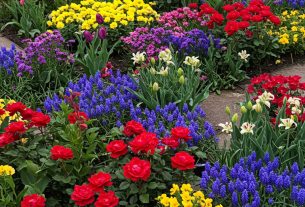As an avid gardener, I often find myself pondering the age-old question: how many plants should I put in my garden? It’s a question that seems simple, yet the answer can significantly impact the health of my plants and the overall aesthetic of my garden. In this article, I will share my insights, strategies, and experiences to help you discover the perfect balance for your own garden. Join me as we delve into the factors that influence plant density and learn how to cultivate a thriving garden.
Understanding Plant Density
Before diving into the specifics of how many plants to include in your garden, it’s essential to understand what plant density means and why it matters. Plant density refers to the number of plants per unit area in a garden space. This concept is crucial because it affects competition for resources such as sunlight, water, and nutrients.
Too many plants can lead to overcrowding, while too few may result in a lack of visual interest and biodiversity. Striking the right balance is key to a flourishing garden.
Factors to Consider When Determining Plant Numbers
Several factors influence the number of plants I choose to include in my garden. Understanding these variables can help you make informed decisions about your own planting strategy.
1. Garden Size
The size of your garden is the most apparent factor to consider. A small balcony garden will obviously accommodate fewer plants than a sprawling backyard. To determine how many plants to include, I often start by measuring the area I have available for planting.
- For small spaces (less than 100 square feet), I typically opt for a maximum of 10-15 plants, depending on their size.
- Medium-sized gardens (100-500 square feet) may comfortably host 20-50 plants.
- Large gardens (over 500 square feet) can support 50+ plants, but careful planning is still necessary.
2. Plant Size and Growth Habit
Different plants have varying growth habits and sizes. Some plants, like tomatoes and sunflowers, grow tall and wide, while others, like herbs and groundcovers, remain smaller. When planning my garden, I always consider the mature size of each plant.
- Large plants should be spaced farther apart to allow for adequate air circulation and sunlight exposure.
- Smaller plants can be planted closer together, but I still need to ensure they have enough room to grow without competing excessively for resources.
3. Growth Conditions
The environmental conditions in my garden, including sunlight, soil quality, and moisture levels, play a crucial role in determining plant density. For example, a garden that receives full sunlight may support more plants than one that is shaded for part of the day.
- In sunny areas, I can plant more sun-loving species, while shaded areas may require fewer plants.
- Well-draining soil may allow for denser planting compared to heavy, compacted soil.
4. Companion Planting
Companion planting is a gardening technique that involves placing plants together that can benefit one another. This approach can influence how many plants I choose to include in my garden.
- For instance, planting basil near tomatoes can enhance the growth of both plants, allowing me to increase overall density.
- Conversely, some plants may compete for the same nutrients or attract pests, which could limit my planting options.
5. Aesthetic Preferences
Finally, my personal aesthetic preferences play a significant role in determining how many plants I include in my garden. I often consider how the colors, textures, and heights of different plants will work together to create a visually appealing space.
- I enjoy creating focal points with larger plants, surrounded by smaller varieties for contrast.
- Grouping plants in odd numbers often creates a more natural look, enhancing overall aesthetics.
Calculating the Right Number of Plants
Now that I understand the key factors influencing plant density, I can move on to calculating the right number of plants for my garden. Here’s how I typically approach this process:
Step 1: Measure Your Garden Area
The first step is to measure the total area of my garden in square feet. For example, if I have a rectangular garden that is 10 feet wide and 20 feet long, I multiply 10 by 20 to get a total of 200 square feet.
Step 2: Research Plant Spacing Requirements
Next, I research the recommended spacing for the specific plants I want to include. This information is often available on seed packets or plant tags and is crucial for ensuring healthy growth. Here are some general guidelines:
- Large plants (e.g., tomatoes, peppers): 18-24 inches apart
- Medium plants (e.g., cabbage, broccoli): 12-18 inches apart
- Small plants (e.g., lettuce, herbs): 6-12 inches apart
Step 3: Calculate Plant Capacity
Once I have the spacing requirements, I can calculate how many plants will fit into my garden area. Using my previous example of a 200-square-foot garden, I can calculate the number of plants as follows:
- For large plants spaced 2 feet apart, I can fit approximately 25 plants (200 square feet ÷ 4 square feet per plant).
- For medium plants spaced 1.5 feet apart, I can fit about 44 plants (200 square feet ÷ 3.5 square feet per plant).
- For small plants spaced 1 foot apart, I can fit around 200 plants (200 square feet ÷ 1 square foot per plant).
Real-Life Examples and Case Studies
To further clarify the concept of plant density, let me share a few real-life examples from my gardening journey.
Example 1: The Small Urban Garden
In my previous apartment, I had a small urban garden measuring just 50 square feet. I decided to grow a mixture of herbs and vegetables. By carefully researching plant spacing and focusing on companion planting, I managed to fit 15 plants: 3 tomatoes, 2 pepper plants, 4 basil, and a few rows of salad greens. This combination not only maximized space but also allowed for a bountiful harvest.
Example 2: The Flower Bed
In my current home, I have a flower bed that measures 120 square feet. I wanted to create a vibrant display of colors and textures. After researching the spacing needs of my chosen flowers, I decided to plant:
- 6 sunflowers (spaced 2 feet apart)
- 12 marigolds (spaced 1 foot apart)
- 15 zinnias (spaced 1 foot apart)
- 20 petunias (spaced 6 inches apart)
This combination resulted in a visually appealing flower bed that attracted pollinators and added beauty to my garden.
Common Mistakes to Avoid
As I’ve navigated my gardening journey, I’ve made my fair share of mistakes regarding plant density. Here are some common pitfalls to avoid:
- Overcrowding: Planting too many plants in a small area can lead to stunted growth and increased susceptibility to pests and diseases.
- Ignoring Plant Needs: Failing to consider the specific needs of each plant type can result in poor growth and overall garden health.
- Neglecting Aesthetics: Focusing solely on the number of plants without considering their arrangement can lead to a chaotic and unappealing garden.
Conclusion: Finding Your Balance
In conclusion, determining how many plants to put in your garden is a nuanced process that requires careful consideration of various factors, including garden size, plant size, growth conditions, companion planting, and personal aesthetics. By understanding these elements and calculating the right number of plants, you can create a beautiful, thriving garden that reflects your personality and enhances your outdoor space.
Remember, gardening is as much about experimentation as it is about planning. Don’t be afraid to adjust your plant numbers as you learn what works best for your unique environment and preferences.
FAQs
1. How can I determine the best spacing for my plants?
Consult seed packets, plant tags, or gardening books for spacing recommendations specific to your plants. Generally, larger plants will require more space than smaller varieties.
2. Can I plant different types of vegetables together?
Yes! Companion planting can enhance growth and deter pests. Just be sure to research which plants benefit each other and which may compete for resources.
3. What if I have limited garden space?
Consider vertical gardening, container gardening, or raised beds to maximize your planting area. Many plants can thrive in smaller spaces if managed properly.
4. How do I know if I’ve planted too many or too few plants?
Monitor your plants closely. If they are struggling to grow, showing signs of stress, or if competition for resources is evident, you may need to adjust your planting density.
If you enjoyed this article and found it helpful, I encourage you to sign up for our newsletter for more gardening tips and tricks. Also, feel free to share this article with friends and spread the love of gardening on social media!
HOME GROWN Organic Cucumber Seeds - 200 Marketmore Heirloom 𝗡𝗢𝗡-𝗚𝗠𝗢 𝗨𝗦𝗔 Vegetable Seeds for Planting in Trellises,Raised Beds,Containers - Beginners and Experienced Gardeners(Cucumis sativus)
$5.66 (as of 11/05/2025 02:19 GMT -03:00 - More infoProduct prices and availability are accurate as of the date/time indicated and are subject to change. Any price and availability information displayed on [relevant Amazon Site(s), as applicable] at the time of purchase will apply to the purchase of this product.)
Sign up for our newsletter and stay up to date with exclusive news
that can transform your routine!




